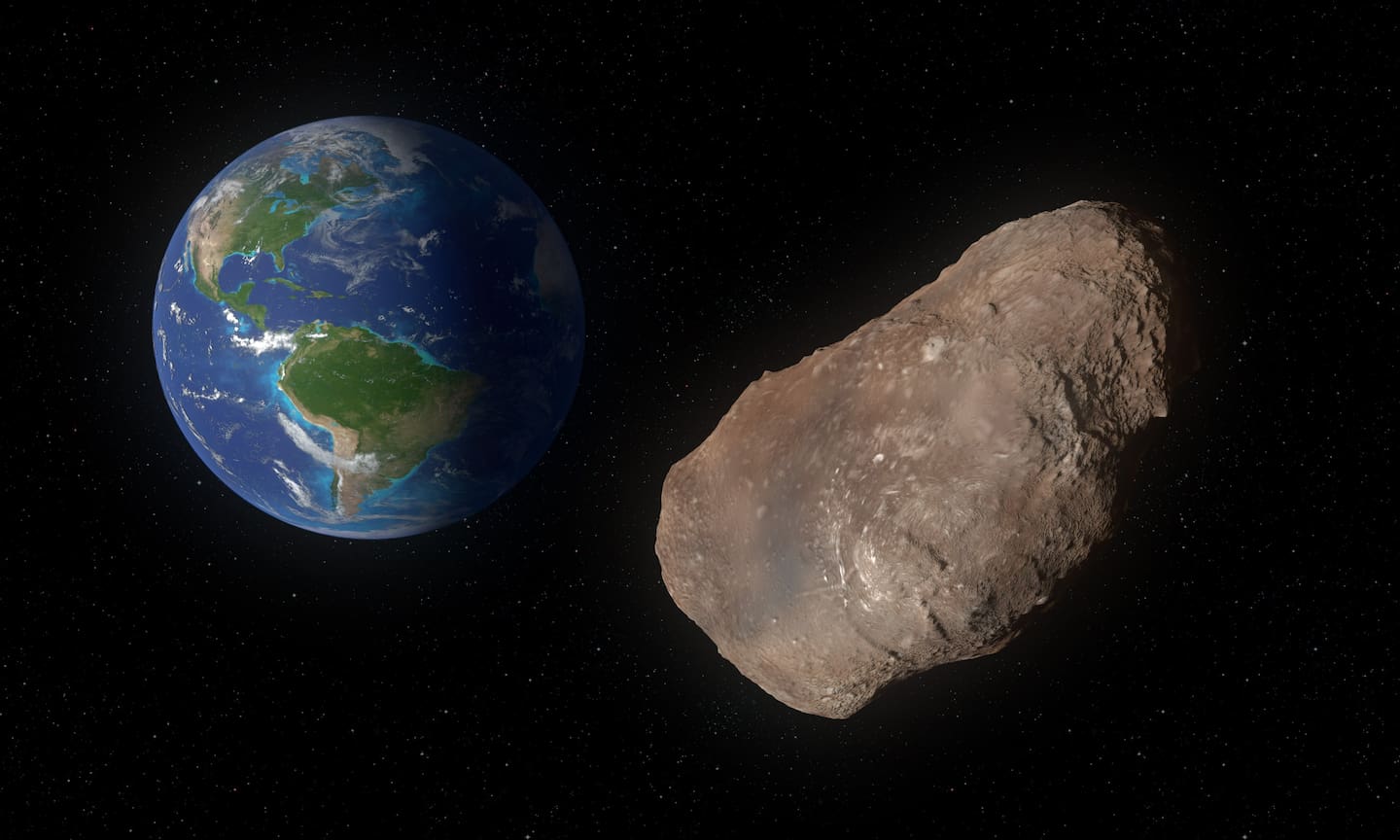
A massive space rock will go hurtling past Earth in a few years, zooming by 10 times faster than a bullet.
This is the first time an asteroid of its size is coming close enough that people in parts of Western Europe and Africa will see it soaring across the sky like a fast-moving star, no fancy telescopes or binoculars required. Around 2 billion people will get to witness this rare event.
To be clear, the asteroid is not going to hit Earth - not in our lifetime nor our children’s lifetimes, anyway. Instead, as if the universe was making a joke, the space rock will make an eerily close flyby on Friday the 13th in April 2029.
The asteroid is named Apophis, and it will come closer to Earth than the satellites that make weather monitoring possible and about 10 times closer than the moon.
“Nature is performing this once-per-several-thousand-years experiment for us. We have to figure out how to watch,” said Richard P. Binzel, a professor of planetary science at MIT.
Apophis is a once-in-a-lifetime opportunity to study asteroids like never before. Getting a close-up look at Apophis will help scientists figure out how to protect our planet against an asteroid that wants to throw a punch at Earth in the future.
But missions to space take years to develop and there are less than five years before Apophis makes its close approach to Earth.
“We’re running out of time,” said Jason Kalirai, executive for space formulation at the Johns Hopkins Applied Physics Laboratory.
Meet Apophis
Apophis is about as wide as the Eiffel Tower is tall. Though scientists do not have pictures of the asteroid yet, they have used radar data to surmise that Apophis is roughly peanut-shaped.
While the rock - which scientists believe has two lobes - is peacefully minding its business in space, that was not the case when it was discovered in June 2004 by scientists at the Kitt Peak National Observatory. Later that year, researchers calculated a 2.7% chance that the asteroid’s encounter with Earth in 2029 would be a violent collision, not a harmless flyby.
“If it was to encounter a populated area, it could take out a city the size of New York,” said Daniella DellaGiustina, lead scientist on a Nasa mission to Apophis called Osiris-Apex.
Apophis made such a bad first impression on the world that it was named after the Egyptian serpentine god of darkness and chaos.
It was not until March 2021 that scientists were able to rule out an Apophis-Earth collision for at least the next 100 years. Using a 70m-long radio antenna in California, scientists collected the data they needed to clear Apophis’s name and remove it from Nasa’s Sentry Impact Risk Table, a list of asteroids with some chance of affecting Earth in the next century.
Apophis will come within 32,000km of Earth - give or take a few miles. When two objects come close in space, they exert forces on each other. Just like Earth experiences tidal forces generated by the moon, Apophis will feel tidal forces generated by Earth.
While the moon’s gravitational pull causes high tides on Earth, Earth’s gravitational pull might cause mini asteroid quakes on Apophis. Apophis’s flyby will mark the first chance to view seismic activity on an asteroid.

A massive space rock will go hurtling past Earth in a few years, zooming by 10 times faster than a bullet. Photo / 123RF
The asteroid space chase
Now that scientists know Apophis will not collide with Earth, they have turned their attention to another problem: how to make it to Apophis in time.
“What are we doing about Apophis? I would say not enough,” Kalirai said.
Though Apophis has been a source of fascination for two decades, no one knows what it actually looks like. Many of its basic properties remain unknown, including its mass and structure.
Recently, Earth’s planetary defense capabilities were put to the test by Nasa’s Double Asteroid Redirection Test, or Dart, in which researchers at Johns Hopkins successfully smashed a spacecraft into an asteroid to change its orbit.
While the researchers are proud of Dart, they emphasised that Earth’s self-defence tool kit is not complete. Planetary defence is not just about throwing celestial upper-cuts. Scientists need to be able to locate asteroids and study their characteristics to mount an effective response.
“Apophis is an opportunity to practice what kinds of characterisation efforts could be done to better understand a particular object. Lessons from that can be applied in the future when we find an asteroid coming our way,” said Terik Daly, a planetary scientist on the Dart and Osiris-Apex missions.
Nasa’s Osiris-Apex mission will redirect an existing spacecraft so that it characterises Apophis after its closest approach to Earth. The mission will study how the asteroid was affected by Earth’s gravity using high-resolution images of Apophis’s surface.
The Osiris-Apex spacecraft can also use its thrusters to kick up dust on the asteroid. With this capability, scientists will learn how strong Apophis’s surface is, which will inform how to deflect it in the future if needed.
If the asteroid has a tough surface that does not break easily, an impact approach like Dart might not be effective in changing the asteroid’s orbit.
A close inspection of asteroids can also help answer long-held questions about the solar system, including where Earth’s water came from. By comparing water on Earth and asteroids, scientists can look for similarities that provide clues about how this important resource arrived on our planet billions of years ago.
But Osiris-Apex cannot stand alone. Since the mission’s spacecraft is already in orbit with limited fuel, it can make it to Apophis only in June, two months after its closest approach to Earth.
If scientists are going to fully understand Apophis and how it was affected by Earth, there need to be missions that study the asteroid before and during its closest approach.
So far, Osiris-Apex is the only confirmed and fully funded mission to Apophis.
‘No bucks, no Bruce Willis’
At Apophis T-5 Years, a two-day workshop to foster international collaboration on Apophis missions, scientists proposed more than 20 spacecraft and payloads combined.
“In an ideal world, we would have a fleet of missions to Apophis,” Kalirai said. But scientists have less than five years to develop, build and launch a mission.
In addition to time, there is a shortage of money to fund missions to Apophis.
“No bucks, no Bruce Willis,” Binzel said.
As a result, many scientists are trying to repurpose old missions to beat the clock and go easy on the wallet.
Experts are urging Nasa to study pre-flyby Apophis with the Janus spacecraft, which were meant to launch in 2023 as part of a separate mission. After delays in that mission, the two spacecraft were put in storage indefinitely.
Scientists at Apophis T-5 Years described a pre-flyby encounter with Apophis as a mission in search of a spacecraft. They believe that need could be met by the Janus satellites, which are spacecraft in search of a mission.
Blue Origin, a private space company founded by Jeff Bezos, reported that its Blue Ring spacecraft could meet Apophis three months before the flyby. The spacecraft has 13 payload slots, allowing the cost of the mission to be shared among multiple parties. (Bezos owns the Washington Post.)
Of all the proposals floating around, a mission developed by the European Space Agency is the closest to fruition. In an act of recycling similar to Osiris-Apex, the ESA’s Rapid Apophis Mission for Space Safety - Ramses - makes use of technology built for the Hera Mission, which is expected to launch this year to study the aftermath of Dart.
Ramses would encounter Apophis two months before its flyby and stay close to watch how it is affected by Earth’s gravity. The mission would monitor how Earth alters Apophis’s rotation, which plays a huge role in what the asteroid’s orbit will look like far into the future.
The Space Safety programme board has given the ESA permission to start working on the mission. However, Ramses is not in the clear yet: the mission awaits final approval for funding by the ESA’s Council of Ministers, who will make their decision at the end of next year.
While space exploration is complicated technically, there have been many advances that make more missions possible and successful. Scientists have even sent a spacecraft to dig into an asteroid and return pieces of it to Earth. As a result, much of the technology needed to explore Apophis exists, making the bottleneck largely financial.
While there is a near-zero chance Earth will meet an asteroid capable of mass extinction soon, there is a 100% probability that a devastating asteroid will risk striking Earth at some point.
“The question is when and whether we’re able to prevent it before that happens,” said Bruce Betts, chief scientist at the Planetary Society, which advocates for space exploration.
Unlike most natural disasters, asteroid collisions are preventable if tools exist to keep track of space rocks and act in self-defence if needed.
Building out Earth’s planetary defence toolkit is not about fear, according to Binzel. “It’s simply about sensible responsibility.”
Joel Achenbach contributed to this report.
Take your Radio, Podcasts and Music with you









